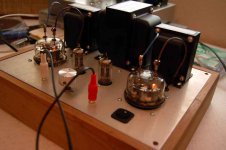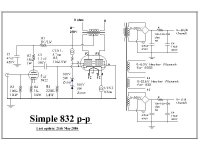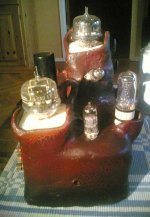About odd looking (HF-tubes), I've got a schematic of a SE-amp using a (Russian) GU72. (Could it be an 872???)
Have you seen that one?
Have you seen that one?
adalin said:I just finnished a new chassie for my amp and hopefully all the pieces will fit in it 🙂
I use the PC connector style for my anodepins, it works pretty good
I have a bunch of 832 and would love if you can give me a schematic of the circuit you used for your amp.
Thanks.
Alex
Alex,
A proven design using the 832 can be found on:
http://www.audiohobbyist.com/projects/832.htm
I am still waiting for the output transformer to arrive, this 832 amplifier is on top of my project list 🙂
A proven design using the 832 can be found on:
http://www.audiohobbyist.com/projects/832.htm
I am still waiting for the output transformer to arrive, this 832 amplifier is on top of my project list 🙂
I dug up these from my AUDIO-folder:
SE: 6N9S_829
6SJ7-829SE
832PP
Coldwar 829PP
12SN7-829SE
PSU to above
Simple 832PP
6N9P-829PP
SE: 6N9S_829
6SJ7-829SE
832PP
Coldwar 829PP
12SN7-829SE
PSU to above
Simple 832PP
6N9P-829PP
For those designs shown using 3E29 / 829B / QQE04-60 / YL1060 strapped as triode in this thread, some of them use real strange operation points. Hence I would suggest to double check with the traced curves, which are available here:
3E29/829B/QQE04-60/YL1060 strapped as triode
Regards,
Tom Schlangen
3E29/829B/QQE04-60/YL1060 strapped as triode
Regards,
Tom Schlangen
Tubes4e4 said:For those designs shown using 3E29 / 829B / QQE04-60 / YL1060 strapped as triode in this thread, some of them use real strange operation points. Hence I would suggest to double check with the traced curves, which are available here:
3E29/829B/QQE04-60/YL1060 strapped as triode
Regards,
Tom Schlangen
Tom,
I wonder if you ever saw a dissipation disparity problem when tracing the curves - wildly different currents in the two sections, resulting in overheating of one section? i seem to remember reading something about it here a long while ago.
Also, i will take this oportunity to thank you for the traced curves for EL509 with low Vg2 and G2 driven. Would you happen to have real traced triode curves as well? I am also looking forward to finding triode curves for the EL/PL508 - perhaps wishful tinking, but you seem to be the person to ask when triode curves are needed 🙂
AcidEye said:Alex,
A proven design using the 832 can be found on:
http://www.audiohobbyist.com/projects/832.htm
I am still waiting for the output transformer to arrive, this 832 amplifier is on top of my project list 🙂
I saw that circuit, I might do that then. Thanks.
Has anybody used the 829/832 for SE?
Thanks
Hi Fellows,
Picture of my 832 amp is below. I used the Audio Hobbyist design and it works quite well. I have not hooked it up to my distortion analyzer yet but it sounds exceptionally good. Very open and plenty of punch. I used some slip on connectors from a terminal block for the plate connections - from a Phoenix terminal block.
Regards,
Picture of my 832 amp is below. I used the Audio Hobbyist design and it works quite well. I have not hooked it up to my distortion analyzer yet but it sounds exceptionally good. Very open and plenty of punch. I used some slip on connectors from a terminal block for the plate connections - from a Phoenix terminal block.
Regards,
Attachments
Shouldn't you put some insulation on those horns? 😱 😱 😱
Alex, the first few posts, including that one from Pete Milette has the 829 wired in triode, I think that's PSE.
Alex, the first few posts, including that one from Pete Milette has the 829 wired in triode, I think that's PSE.
Hi Arnold,
Well, I guess most people would insulate them. But I have no kids, no pets, no spouse and my girlfriend knows better than to touch those leads, so it's probably OK. It works for me but it might not work for everyone. Safety first and it is important.
The amp sounds great and I'm quite happy with it. The 832's work quite well. The plates glow just slightly red, which is how I like it. I did not put blue LED's in the bottom. And those are Hammond 1608 OPT's.
Regards,
Well, I guess most people would insulate them. But I have no kids, no pets, no spouse and my girlfriend knows better than to touch those leads, so it's probably OK. It works for me but it might not work for everyone. Safety first and it is important.
The amp sounds great and I'm quite happy with it. The 832's work quite well. The plates glow just slightly red, which is how I like it. I did not put blue LED's in the bottom. And those are Hammond 1608 OPT's.
Regards,
Hi,
I design and build a low power Simple 832 pp not too long ago, sound bright, open, punchy and its nothing close to sweet to me.
Just watch out for the Screen Grid current. And since the cathode for the 2 beam tetrode are common, I have no idea as of how to balance the 2 plate currents.
Cheers
I design and build a low power Simple 832 pp not too long ago, sound bright, open, punchy and its nothing close to sweet to me.
Just watch out for the Screen Grid current. And since the cathode for the 2 beam tetrode are common, I have no idea as of how to balance the 2 plate currents.
Cheers
Attachments
arnoldc said:Shouldn't you put some insulation on those horns? 😱 😱 😱
Alex, the first few posts, including that one from Pete Milette has the 829 wired in triode, I think that's PSE.
Thanks.
I will go with the PP configuration as per audiohobbyist.com, but might go for a better PSU design that I have learned from my mentors.
Hi Arnold,
Actually, the output stage is very tolorent to PS noise, I fine it sufficiently quiet from my 96db speakers with a single 330uf cap for the power stage, but more attention is required for the driver stage, and sounded lifely too. (And cheap too cool: )
I personally hear that it kills the sound if you regulate the voltage here. or pile up too much capacitors. But if your findings proove othterwise, please share your technique.:
I didn't do any measurements, but from the datasheet, it shows that this tube is highly distorted... BUT, to me, it distorted in a ear pleasing way 😉
Happy building
Actually, the output stage is very tolorent to PS noise, I fine it sufficiently quiet from my 96db speakers with a single 330uf cap for the power stage, but more attention is required for the driver stage, and sounded lifely too. (And cheap too cool: )
I personally hear that it kills the sound if you regulate the voltage here. or pile up too much capacitors. But if your findings proove othterwise, please share your technique.:
I didn't do any measurements, but from the datasheet, it shows that this tube is highly distorted... BUT, to me, it distorted in a ear pleasing way 😉
Happy building
Regarding triode strapped EL509
Hi ilimzn,
Triode strapped EL509 curves are on top of the tracing list, indeed. Probably not this weekend, though.
Regards,
Tom
Hi ilimzn,
Would you happen to have real traced triode curves as well? I am also looking forward to finding triode curves for the EL/PL508 - perhaps wishful tinking, but you seem to be the person to ask when triode curves are needed 🙂
Triode strapped EL509 curves are on top of the tracing list, indeed. Probably not this weekend, though.
Regards,
Tom
Re: Regarding triode strapped EL509
No hurry, as long as we all get to see them in some forseeable future 🙂
BTW just to be clear, my interest in EL509/519 trioded curves notwithstanding, when I wrote above about the EL/PL508, it was not a mistype. EL/PL509 liiks like a shorter EL/PL504 without the top cap, was used for vertical deflection in large screen color TVs, and has a 12W nominal plate dissipation, even though the structure inside is quite huge (about the same as a PL36 or PL500).
Tubes4e4 said:Hi ilimzn,
Triode strapped EL509 curves are on top of the tracing list, indeed. Probably not this weekend, though.
Regards,
Tom
No hurry, as long as we all get to see them in some forseeable future 🙂
BTW just to be clear, my interest in EL509/519 trioded curves notwithstanding, when I wrote above about the EL/PL508, it was not a mistype. EL/PL509 liiks like a shorter EL/PL504 without the top cap, was used for vertical deflection in large screen color TVs, and has a 12W nominal plate dissipation, even though the structure inside is quite huge (about the same as a PL36 or PL500).
adalin said:Im allmost finnished with my experimental 832 amp, here is a sneakpeak 🙂
That looks cool and far out!
- Status
- Not open for further replies.
- Home
- Amplifiers
- Tubes / Valves
- 829 or GU-29 audio amplifier schematics?
![gu-72[1].gif](/community/data/attachments/83/83777-b693a3f73b6fba68c7ee0eaa9a557478.jpg?hash=tpOj9ztvum)



